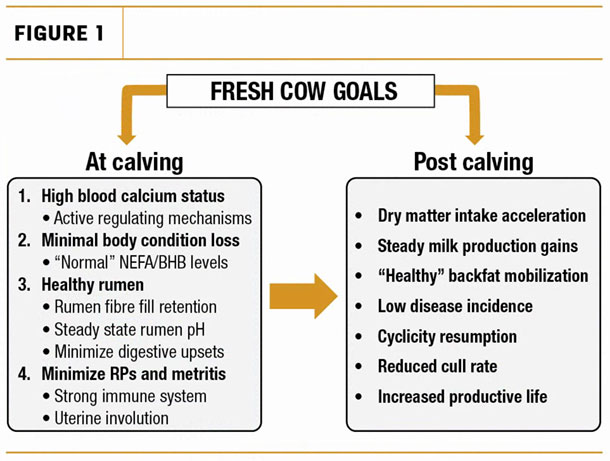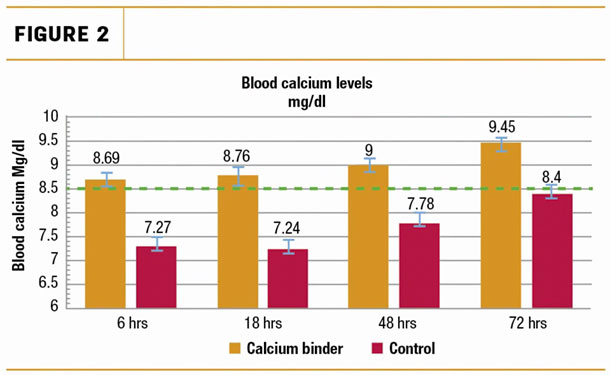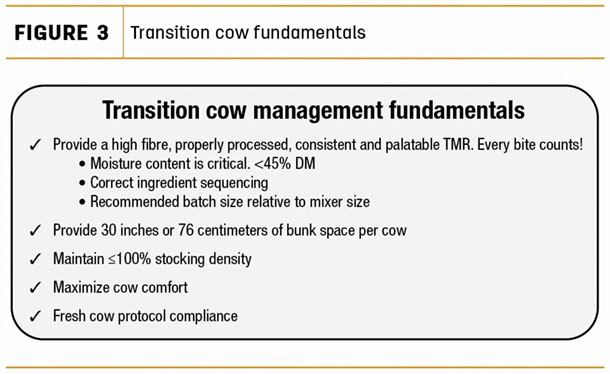Despite significant strides made through research and improved management strategies, there are numerous on-farm and individual cow risk factors that come into play, resulting in a fine line between achieving a successful transition or one that always seems to be a work in progress.
Clinical and subclinical hypocalcemia has been established as the gateway disease leading to a higher probability of metabolic disease, lower milk production, reduced reproductive efficiency, compromised immune function and a subsequently higher cull rate. Clinical hypocalcemia (down cows) affects 2% to 5% of all second-lactation-and- older cows. Subclinical hypocalcemia affects 50% to 70% of second-lactation-and-older cows.
Symptoms of subclinical hypocalcemia (SCH) may not be visually apparent, but borderline low blood calcium levels have been shown to be an important predictor of fresh cow problems. The effects of clinical hypocalcemia are financially significant; however, subclinical hypocalcemia is more costly because it affects a higher percentage of fresh cows. In the understatement of the year, a successful transition period is one of the most important areas for a profitable dairy business.
The dry period and, more importantly, the 21-day pre-fresh period sets the stage for achieving the transition goals shown in Figure 1, assuming the essential environmental, management and nutritional boxes are checked.

These fresh cow goals really have not changed much over time – just a few more fancier terms. When I first started making farm calls some 35 years ago, providing practical nutritional strategies to minimize clinical hypocalcemia/down cows and achieving fresh cow success was a high priority. Today, it still is.
Through many years of ongoing research, nutritional strategies to prevent hypocalcemia have been extensively studied. From a nutritionist perspective, I have seen numerous strategies implemented to minimize hypocalcemia, but results have been inconsistent. Initially, the focus was on minimizing dietary calcium to “turn on” the calcium-regulating mechanisms to prepare the fresh cow to meet the high metabolic calcium demand of calving. However, it was impossible to achieve a low enough dietary calcium level with conventional feedstuffs available. Later, it was determined that dietary potassium played a significant role in minimizing hypocalcemia. Consequently, the nutritional focus has been on sourcing low-potassium forages and feeding negative dietary cation anion difference (DCAD) diets.
Recently, a calcium binder approach has come to the market. The idea of minimizing dietary calcium is not new and was initially recommended in the 1980s. The difference today is this calcium binding technology allows us to truly minimize dietary calcium absorption, creating a negative calcium balance. The negative calcium balance then activates the calcium-regulating mechanism. When this machinery is fully functioning at calving, fresh cows are better able to meet the high metabolic calcium demands and achieve a more seamless transition. Research results and field experience has been positive. In the 48- to 72-hour window following calving, consistently higher blood calcium levels have been achieved. This is showcased in a recently published research trial at Cornell University (Figure 2).

In contrast to the negative DCAD approach, the calcium binding strategy allows producers to grow and feed more home-grown forages instead of sourcing low-potassium forages and routinely monitoring urine pH. In addition, higher blood calcium levels should reduce the need for supplemental calcium boluses, minimizing fresh cow touches. Calcium boluses should still be available for high-risk cows as part of a standard preventative program. Overall, a calcium binder strategy may simplify the implementation and management of your pre-fresh feeding program.
Extensive DCAD research has continued since its introduction, but research also continues on the calcium binding approach to fully understand mode of action and fine-tune its application. This strategy results in lower blood phosphorus levels at calving, but blood levels rebound quickly by day 2 and 3 post-calving and no negative health outcomes have been observed. Regardless, a better understanding of the role of dietary phosphorus and phosphorus absorption is needed. It is interesting to note that there is published university research from many years ago correlating lower dietary phosphorus pre-fresh to higher blood calcium levels post-fresh.
In simple terms, the lower the dietary phosphorus fed during the pre-fresh period, the higher blood calcium achieved at calving. However, this lower dietary phosphorus recommendation is in contrast of what we may typically see at the farm level. With the concern from producers for potential of “low-phosphorus” milk fevers and the common inclusion of higher-phosphorus byproducts, we have seen much higher dietary phosphorus levels being fed. Regardless of the type of pre-fresh strategy used, the data strongly suggests that lower dietary phosphorus (less than 0.35%) should be targeted.
As with a winning football program, blocking and tackling fundamentals need to be in place for success. Without these finely tuned skills, the playbook will not be successful, and it will be a long season. By the same token, the following transition cow fundamentals need to be in place (Figure 3).
 Consistently meeting these on-farm fundamentals 24-7 is not easy, but it is worth the effort since these fundamentals play such a critical role in transition cow success. Without these fundamentals, increased fresh cow issues are more likely to occur regardless of the pre-fresh nutritional strategy implemented.
Consistently meeting these on-farm fundamentals 24-7 is not easy, but it is worth the effort since these fundamentals play such a critical role in transition cow success. Without these fundamentals, increased fresh cow issues are more likely to occur regardless of the pre-fresh nutritional strategy implemented.
Achieving transition cow success is challenging for both cows and producers. A seamless transition into lactation is essential to maintain health and achieve expected production goals. In addition to the negative DCAD approach, a calcium binding strategy provides a viable option for minimizing hypocalcemia.
Regardless of the nutritional strategy being considered, a farm-specific analysis is necessary to determine which approach is the best fit based on the unique properties and health challenges specific to that farm. Work closely with your nutritionist and veterinarian to check those boxes that will lower risk and increase your chances for transition cow success. ![]()

-
Rod Martin
- Dairy Nutritionist and Business Development – USA
- Protekta Inc.
- Email Rod Martin








